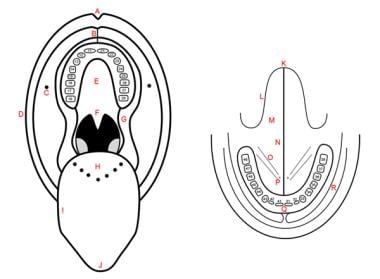Overview
The oral cavity represents the first part of the digestive tube. Its primary function is to serve as the entrance of the alimentary tract and to initiate the digestive process by salivation and propulsion of the alimentary bolus into the pharynx.
It also serves as a secondary respiratory conduit, a site of sound modification for the production of speech, and a chemosensory organ.
The mobility of the lips is also critical to speech production, whistling, singing, the playing of wind and brass musical instruments, expectoration, and human behavioral communication (eg, kissing, smiling, pouting, baring of teeth).
Even minor disruptions in the function of the oral cavity can seriously jeopardize an individual’s quality of life.
The oral cavity (see the image below) is oval shaped and is separated into the oral vestibule and the oral cavity proper.
It is bound by the lips anteriorly, the cheeks laterally, the floor of the mouth inferiorly, the oropharynx posteriorly, and the palate superiorly.
The oropharynx begins superiorly at the junction between the hard palate and the soft palate, and inferiorly behind the circumvallate papillae of the tongue.
The bony base of the oral cavity is represented by the maxillary and mandibular bones.
Schematic representation of oral cavity and floor of mouth. A: philtrum; B: upper labial frenulum; C: opening of Stensen’s duct; D: labial commissure; E: hard palate; F: soft palate; G: intermaxillary commissure; H: base of tongue; I: lateral border of tongue, dorsal view; J: tip of tongue, dorsal view; K: tip of tongue, ventral view; L: lateral border of tongue, ventral view; M: ventral surface of tongue; N: lingual frenulum; O: floor of mouth; P: opening of Wharton’s duct; Q: vestibular gingiva; R: vestibule. Teeth are numbered according to international classification.
The oral cavity includes the lips, gingivae, retromolar trigone, teeth, hard palate, cheek mucosa, mobile tongue, and floor of the mouth. The major salivary glands are in close relation with oral cavity structures, although they are not part of the oral cavity. The tongue is part of the oral cavity; its anatomy is specifically described elsewhere (see Tongue Anatomy). The palatine tonsils, soft palate, tongue base, and posterior pharyngeal walls are part of the oropharynx; the oropharynx is not part of the oral cavity.

